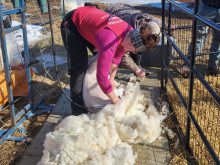After four years of drought, Joan Hughson has stared into the abyss and seen disaster staring back.
“I have not had an inch of moisture this spring,” she said from her ranch 30 kilometres south of Foremost in southeastern Alberta.
“We’ re looking at disaster and bankruptcy.”
Some neighbors have sold their cow herds while others are hauling water to cattle in hopes of hanging on a little longer.
Hughson is one of the lucky ones. She has natural springs on her property, providing enough livestock and household water.
Read Also

Charges laid after cattle theft
Saskatchewan RCMP lay two charges against a man after six cattle went missing.
She and her sons also have cropland and have turned their cattle into the fields for grazing because the pastures never grew.
Provincial government money announced earlier this month may save some producers for another year, yet Hughson is still waiting for the rest of last year’ s drought payment. Her region is also part of a grass insurance pilot program this year, so hope remains for a payout on failed forage crops.
Meanwhile, varying amounts of rain arrived in other areas, offering respite from a potential disaster in eastern Alberta. If the showers stop, moisture levels will revert within a couple of weeks.
“If it is dry and clear, we will be toast,” said Debra Bullick, who farms with her husband Ron near Coronation in east-central Alberta.
“Everything will be craters and we won’ t last the summer.”
They received enough showers to green up the slow-growing pastures in unseasonably cool weather. Frost has appeared several mornings.
A cool spring with spotty showers is the common theme throughout the province, said soil specialist Joe Michielsen of Alberta Agriculture.
The Peace River district has made the greatest moisture turnaround. Fort. St. John and Dawson Creek have received about 150 millimetres of rain so far.
Western Alberta is in reasonably good shape, but scattered showers are not enough to refill dried out dugouts or relieve sparse pasture. Subsoil moisture is not being recharged.
In Saskatchewan, timely rains have relieved the drought experienced in most of the province.
Up to 25 millimetres fell on some of the most parched areas last weekend. It was enough to stimulate crop and pasture growth, said Jim Pratt, a Saskatchewan Agriculture soil and crops specialist in Swift Current.
Unlike many parts of Alberta, subsoil moisture was good, so recent showers revived struggling crops that have rooted deeply enough to draw water. However, most crops remain 10 days to two weeks behind schedule.
Dugouts did not freshen this spring because there was no runoff. Remaining water quality is poor and cattle producers must decide what to do with cows this summer.
“There are some major, tough decisions being made as to what to do with these animals,” Pratt said.
In southeastern Saskatchewan, conditions are wet and cool, similar to the Manitoba experience.
Most of Manitoba is saturated.
Manitoba Agriculture reports most regional moisture levels as ideal to wet, which continues to stall seeding.
A weekend rain ranged from 13-50 mm across the province, including some dry regions in the northwest.
Pastures in the northwest continue to be dry compared to the rest of the province, where haying has started and pastures look lush.

















